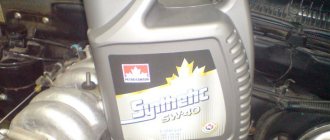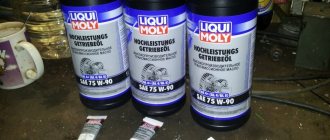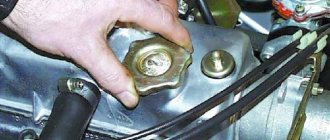The steering mechanism of a car consists of a steering wheel, a shaft, a gearbox, rods, a trapezoid, a pendulum and steering knuckles.
Due to the steering gear, which transmits forces from the steering wheel to the rods, the front wheels of the car rotate at a given angle.
Transmission oil poured into the steering system helps ensure stable operation of the gearbox and reduce wear on its parts. If it leaks, which occurs regardless of the condition of the gearbox, and untimely replacement occurs, the problem of dry friction in the unit arises. As a result, the quality of driving deteriorates, the rotation of the steering wheel becomes difficult, and its play increases.
Let's take a closer look at what oil is used for the VAZ 2107 steering gear, how to check its level and replace it.
Changing the oil in the steering mechanism and adjusting the steering play
The problem of steering wheel play in classic cars is not new; every owner has encountered it, and while in the city it is still possible to drive with play, on the highway you get tired of constantly catching the car and any trip over any serious distance is very tiring. Solving this problem is very simple. : just tighten the adjusting bolt. We also have 0.18 liters of oil poured into the steering mechanism. I think few owners of classics changed the oil there (actually, I never thought about it either), and yet the oil change interval set by the manufacturer is 60,000 km. The steering mechanism is not demanding on the quality of the oil, the main thing is that it just needs to be there. Therefore, I did not buy expensive oil, but bought 1 liter of Lukoil TM-5 80w90 mineral oil for 150 rubles.
I also bought a “measuring” cup, a 20ml syringe and a drip set.
We will need a tube from the dropper since we do not have a drain plug, but only a filler plug, which performs both functions.
Because any VAZ steering mechanism leaks, over time a layer of dirt accumulates on it, it must be cleaned off so that it does not get into the oil. This is what it looks like
We unscrew the plug with a key 8, insert the tube from the dropper inside and suck out the old oil with a syringe, if it is still there, I had about 40 ml out of 180. After this, you can fill in new oil, at a level of about 15 ml below the filler hole, after that we tighten traffic jam
Next, remove the boot from the adjusting bolt, unscrew the nut with an 18mm wrench, remove the sprocket and tighten the bolt with a flat screwdriver. Important point: before adjusting, you need to set the wheels straight, and then after each tightening of the bolt, turn the steering wheel half a turn with sharp movements left and right and watch To prevent the steering wheel from biting, after adjustment, put on the sprocket and tighten the nut, do not forget to put on the boot.
After the work done, I felt like I was driving a different car, the steering wheel began to turn easier and the play disappeared almost completely, I regret that I didn’t do this 3 years ago. I recommend it to all owners of classics.
Source
When replacement may be needed
The lubricant loses its properties over time. The oil in the bridge must be changed regularly, according to the instructions. But during operation, signs of malfunctions may appear, which indicate the need for a faster change of waste fluid:
- whistling and noise appear from the side of the bridge;
- when the nature of the load changes, knocking noises become audible;
- There are drips and traces of oil fluid on the gearbox.
The car care instructions state that in the VAZ-2107 the rear axle oil is changed for the first time after running in (2000 km). And then it needs to be changed every 60 thousand kilometers. But, given the difficult climatic conditions with ultra-low temperatures, bad roads and constant driving in city traffic jams, it is recommended to fill in new oil after 30 - 35 thousand kilometers. Unscheduled maintenance when purchasing a used car, major repairs are also accompanied by the replacement of lubricant.
Experts advise changing the lubricant in different seasons (winter and summer). In winter, the oil composition should be more liquid, with a lower pour point. And in summer it is more viscous.
Changing the oil in the steering gearbox on a VAZ 2101-VAZ 2107
Welcome! Steering gear – this unit has many names, some call it “Steering column”, some call it “Steering mechanism”, and some call it “Steering gear”. In fact, of all these names listed, the most reliable is only “Steering mechanism” because this is the name given to this unit during the creation of cars of the “Classic” family.
But not all car owners know why the car needs this part, so today we will briefly tell you about it and show you instructions for changing the oil in the steering gear, which is located just below.
Note! To change the oil you will need: A clean cloth or, instead, it is best to use a wire brush to remove dirt from the gear housing cover!
In addition to these devices, you also need to stock up on: A screwdriver, as well as a basic set of wrenches, a “12” hexagon and a regular or oil syringe for pouring oil into the gearbox!
Summary:
Briefly about the steering gear: This is the most important component of the steering gear, because thanks to this unit, when you turn the steering wheel, the wheels of the car also turn, that is, it transmits the force when turning the steering wheel to the wheels, thereby steering the car.
When should you change the steering gear oil? Many people say that there is no need to change the oil in the steering mechanism, but if you look at it from the other side, there is still a need to change the oil. Almost any oils after a certain period of time lose their properties and they begin to oxidize. Due to oxidation, they begin to leave sediment on the walls, thereby polluting the system and therefore, I think it’s worth spending money on “1 liter” of gear oil.
Note! By the way, it is necessary to change the oil in the steering gear housing very rarely, approximately “20,000 - 40,000 thousand km” because constantly changing the oil is really just a waste of money. But if the oil has already lost its additives and therefore it has turned very black, accompanied by heavy turning of the steering wheel, then in this case it is necessary to change the oil as quickly as possible so that everything returns to normal!
How much oil is required
Before proceeding directly to the procedure, you should decide how much oil to fill. According to the manual, the volume of oil required in the drive axle gearbox of the “classic” is 1.35 liters. Therefore, when preparing for the procedure for changing it, it is recommended to prepare a larger amount - approximately 1.5 liters of liquid. The remaining volume is needed for internal cleaning of the gearbox: the mixture with diesel fuel is poured.
Replacement
The oil is changed according to the same algorithm as the oil in the gearbox, after a mileage, so that the oil is hot and drains better:
Changing the oil in the steering gearbox on a VAZ 2107-2101
— place a container for used oil under the drain hole
- after the oil has completely drained, tighten the drain plug
- pour oil into the filler hole until oil flows out of it
How to change the oil in the steering gearbox, also known as the steering mechanism, on a VAZ 2101-VAZ 2107?
Note! Before you start replacing, check the oil level in the system and be sure to look where the steering mechanism is located and how to understand when it’s time to change the oil! (For answers to all these questions, see the article: “Checking the oil level in the steering column”)
Draining: 1) First, check that the car’s engine is warmed up to operating temperature, and if necessary, then get into the car and warm it up so that the engine is warmed up to its operating temperature.
Note! This is necessary so that the old oil drains faster from the steering gear housing, and also so that dirty oil residues also come off the cylinder walls. Also, keep in mind that when the engine is warm, the oil will be hot, so be careful and don’t hurt your hands!
Checking the oil level
Control checks of the fluid volume in the gearbox should be carried out every 10 thousand kilometers, as well as when malfunctions or visual leaks occur. Checking the oil level in the rear axle is quite simple. To do this, you will need a container with a volume of about one and a half liters, a 17mm wrench and a screwdriver. The next steps are:
- the car is placed on a viewing hole, overpass or lift;
- the filler plug is cleaned of dirt;
- use a 17 key to unscrew the filler plug;
- The oil level is controlled with a screwdriver: the liquid should reach the edge of the hole.
If there is insufficient protective liquid, it is necessary to add it using a syringe or other device.
PURPOSE, MALFUNCTIONS AND REPAIR OF THE VAZ 2107 STEERING GEAR
Steering is present in all cars, regardless of class and year of manufacture. The device must always be in good condition and any changes to it are prohibited. The VAZ 2107 and other classic Zhiguli models are equipped with a worm-type steering column, which requires periodic inspection and sometimes repair.
STEERING MECHANISM VAZ 2107 - BRIEF DESCRIPTION
The steering mechanism of the VAZ “Seven” has a rather complex design, which ensures reliable vehicle control in different driving situations. The steering wheel is endowed with good information content, which eliminates driver fatigue when traveling long distances. There are some difficulties when turning the steering wheel while the car is stationary. However, as soon as the car starts moving, the steering becomes less rigid and control improves.
The steering mechanism has one nuance - a slight play, which is normal. This is explained by the considerable number of parts in the gearbox and the presence of rods. After modernization, the VAZ 2107 began to be equipped with a safety column, which has a composite shaft. Its design consists of two cardan-type joints, which allow the shaft to fold in the event of an accident. In this way, injury to the driver is avoided.
STEERING GEAR REDUCER DEVICE
Before you begin repairing the steering column, you need to familiarize yourself with its structure, as well as its operating principle. The design consists of the following main elements:
- a unit designed to transmit force from turning the steering wheel to actuators;
- steering column, which turns the wheels to the desired angle.
The steering mechanism consists of:
- composite shaft with cardan transmission;
- steering wheel;
- worm type steering gear.
The design has the following components:
- pendulum;
- swing arms;
- steering rods.
Since the outer rods have two parts, this allows the toe angle to be adjusted. The steering functions as follows:
- The driver operates the steering wheel.
- Through universal joints, the worm shaft is driven, through which the number of revolutions is reduced.
- The worm rotates, which helps move the double-ridge roller.
- The secondary shaft of the gearbox turns.
- A bipod is mounted on the secondary shaft, which rotates and carries the steering rods with it.
- Through these parts, force is applied to the levers, thereby turning the front wheels to the angle desired by the driver.
The bipod is a rod that connects the steering gearbox to the steering linkage.
SIGNS OF GEARBOX FAILURE
As the vehicle is used, the steering column may develop problems that require repair. The most common of them are:
- oil leak from the gearbox;
- extraneous sounds in the mechanism;
- It takes a lot of effort to turn the steering wheel.
TABLE: VAZ 2107 STEERING MALFUNCTIONS AND WAYS TO SOLUTION THEM
| Malfunctions | Elimination method |
| Increased free play of the steering wheel | |
| Loosening the steering gear mounting bolts. | Tighten the nuts. |
| Loosening the tie rod ball pin nuts. | Check and tighten the nuts. |
| Increased clearance in the ball joints of the steering rods. | Replace tie rod ends or tie rods. |
| Increased clearance in the front wheel hub bearings. | Adjust the gap. |
| Increased clearance in the engagement of the roller with the worm. | Adjust the gap. |
| There is too much clearance between the swingarm shaft and the bushings. | Replace the bushings or bracket assembly. |
| Increased clearance in the worm bearings. | Adjust the gap. |
| Stiff steering wheel rotation | |
| Deformation of steering gear parts. | Replace deformed parts. |
| Incorrect alignment of the front wheel angles. | Check the wheel alignment angles and adjust. |
| The gap in the engagement of the roller with the worm is broken. | Adjust the gap. |
| The adjusting nut of the pendulum arm axis is overtightened. | Adjust the tightening of the nut. |
| Low pressure in the front tires. | Set the pressure to normal. |
| Damage to ball joint parts. | Check and replace damaged parts. |
| There is no oil in the steering gear housing | Check and top up. Replace the oil seal if necessary. |
| Damage to upper steering shaft bearings | Replace bearings. |
| Noise (knocking) in the steering | |
| Increased clearance in the front wheel hub bearings. | Adjust the gap. |
| Loosening the tie rod ball pin nuts. | Check and tighten the nuts. |
| Increased clearance between the pendulum arm axis and the bushings. | Replace the bushings or bracket assembly. |
| The adjusting nut of the pendulum arm axis is loose. | Adjust the tightening of the nut. |
| The clearance in the engagement of the roller with the worm or in the worm bearings is broken. | Adjust the gap. |
| Increased clearance in the ball joints of the steering rods. | Replace tie rod ends or tie rods. |
| Loosening of the steering gear mounting bolts or the swing arm bracket. | Check and tighten the bolt nuts. |
| Loosening the nuts securing the swing arms. | Tighten the nuts. |
| Loosening the steering intermediate shaft bolts. | Tighten the bolt nuts. |
| Self-excited angular oscillation of the front wheels | |
| Tire pressure is not correct. | Check and set normal pressure. |
| 2. The alignment angles of the front wheels are incorrect. | Check and adjust wheel alignment angles. |
| 3. Increased clearance in the front wheel hub bearings. | Adjust the gap. |
| 4. Wheel imbalance. | Balance the wheels. |
| 5. Loosening the tie rod ball pin nuts. | Check and tighten the nuts. |
| 6. Loosening the bolts securing the steering mechanism or the pendulum arm bracket. | Check and tighten the bolt nuts. |
| 7. The gap in the engagement of the roller with the worm is broken. | Adjust the gap. |
| Steering the vehicle away from straight-line motion in one direction | |
| Uneven tire pressure. | Check and set normal pressure. |
| The alignment angles of the front wheels are incorrect. | Check and adjust wheel alignment angles. |
| Different draft of front suspension springs. | Replace unsuitable springs. |
| Steering knuckles or suspension arms are deformed. | Check the fists and levers, replace unsuitable parts. |
| Incomplete release of the brakes on one or more wheels. | Check the condition of the brake system. |
| Vehicle instability | |
| The alignment angles of the front wheels are incorrect. | Check and adjust wheel alignment angles. |
| Increased clearance in front wheel bearings. | Adjust the gap. |
| Loosening the tie rod ball pin nuts. | Check and tighten the nuts. |
| There is too much play in the tie rod ball joints. | Replace tie rod ends or tie rods. |
| Loosening of the steering gear mounting bolts or the swing arm bracket. | Check and tighten the bolt nuts. |
| Increased clearance in the engagement of the roller and worm. | Adjust the gap. |
| Steering knuckles or suspension arms are deformed. | Check the knuckles and levers; replace deformed parts. |
| Oil leak from crankcase | |
| Wear of the bipod or worm shaft seal. | Replace the seal. |
| Loosening the bolts securing the steering gear housing covers. | Tighten the bolts. |
| Damage to sealing gaskets. | Replace gaskets. |
Functions of power steering fluids
The functions of power steering oils include:
- transfer of pressures and forces between the working bodies of the system;
- lubrication of power steering components and mechanisms;
- anti-corrosion function;
- transfer of thermal energy to cool the system.
Hydraulic oils for power steering contain the following additives:
PSF fluid for power steering
- reducing friction;
- viscosity stabilizers;
- anti-corrosion substances;
- acidity stabilizers;
- coloring compounds;
- antifoam additives;
- compositions for protecting rubber parts of the power steering mechanism.
ATF oils perform the same functions, but their differences are as follows:
- they contain additives that increase the static friction of clutches, as well as reduce their wear;
- The different fluid compositions are due to the fact that clutches are made of different materials.
Any power steering fluid is created on the basis of a base oil and a certain amount of additives. Due to their differences, the question often arises as to whether different types of oils can be mixed.
ADJUSTING THE STEERING COLUMN
Adjustment work on the steering gearbox on a VAZ 2107 is resorted to when the steering wheel becomes difficult to rotate, jamming occurs during rotation, or when the steering shaft moves along the axis with the wheels straight.
To adjust the steering column, you will need an assistant, as well as a 19-mm wrench and a flat-head screwdriver. The procedure is carried out in the following sequence:
- The machine is installed on a flat horizontal surface with the front wheels located in a straight line.
- Open the hood and clean the steering gear from contamination. The adjustment screw is located on top of the crankcase cover and is protected by a plastic plug, which is pryed off with a screwdriver and removed.
- The adjusting element is secured with a special nut to prevent spontaneous unscrewing, which is loosened with a 19 mm wrench.
- The assistant begins to intensively rotate the steering wheel to the right and left, and the second person uses the adjusting screw to achieve the desired position in the mesh of the gears. In this case, the steering wheel should rotate easily and have minimal free play.
When the adjustment is completed, hold the screw with a screwdriver and tighten the nut.
VIDEO: ADJUSTING THE STEERING UNIT VAZ 2107
GEAR OIL
To reduce friction of the internal elements of the steering column, GL-4, GL-5 transmission oil with a viscosity grade of SAE75W90, SAE80W90 or SAE85W90 is poured into the mechanism. In the old fashioned way, many car owners use TAD-17 oil for the unit in question. The filling volume of the gearbox on the VAZ 2107 is 0.215 liters.
CHECKING THE OIL LEVEL
To avoid premature failure of mechanism parts, it is necessary to periodically check the oil level and replace it. It is worth taking into account that the fluid from the gearbox, although slowly, leaks, and the leak occurs regardless of whether the column is new or old. The level check is performed as follows:
- Use a 8 wrench to unscrew the filler plug.
- Using a screwdriver or other tool, assess the oil level in the crankcase. The normal level should be at the bottom edge of the filler hole.
- If necessary, add lubricant using a syringe until it begins to flow out of the filler hole.
- Tighten the plug and wipe the steering gear from smudges.
HOW TO CHANGE THE OIL IN THE GEARBOX
As for changing the oil in the steering device, this procedure should be carried out every year and a half. If the decision has been made to change the lubricant, you need to know how to perform the procedure. In addition to the new lubricant, you will need two syringes of the largest possible volume (purchased at the pharmacy) and a small piece of washer hose. The procedure is carried out in the following order:
- Use a key to unscrew the filler plug, place a piece of tubing on the syringe, draw in the old oil and pour it into the prepared container.
- Using a second syringe, new lubricant is poured into the gearbox to the required level, while it is recommended to rotate the steering wheel.
Which lubricant to choose
Many drivers have a reasonable question: what kind of oil to fill? Oil
Mechanics recommend filling the rear axle gearbox of a VAZ-2107 with a viscosity of 75W90, 80W90 or another suitable one with API classification GL-4/GL-5.
For example, Castrol 75W90, Lukoil 80W90. In winter, it is better to fill the rear axle of the VAZ- 2107
with synthetics. In summer, mineral water.
How much to fill (volume)
You won’t believe it, but there are also owners who don’t even know that the rear axle of a car also needs regular lubrication, although not as often as the engine. Also, there are drivers who believe that if the oil does not expel or ooze, there is no need to change it at all. This is all wrong and it is also necessary to perform this procedure, as in the internal combustion engine and in the gearbox.
The lubricant volume should be 1.3 liters. To fill the required level, you need to wait until the oil flows from the filler hole; this will be considered the optimal volume.
Answers (2)
you can fill in Lukoil TM5 80w90, and TAD-17 Type TM-5-18 80W-90 is also suitable
How much volume should be poured into the steering column of a gazelle?
Welcome! “Please tell me: What kind of oil should be poured into the steering gear housing?” In fact, we are asked this question very often, because practically no books contain this answer at all. Therefore, today we will examine this issue in detail.
What kind of oil should be poured into the steering mechanism?
A car without “Power Steering - Hydro Power Steering”: In such cars, ordinary transmission oil is poured into the crankcase of the mechanism, which is also recommended to be changed after a very long period of time (3-10 years, depending on the quality of the oil).
Note! Before purchasing transmission oil for the steering mechanism, be sure to check with the seller at what temperatures it freezes, otherwise freezing of the oil in the steering gear housing will not lead to anything good, and freezing of the oil will be accompanied by heavy turning of the steering wheel!
Car with power steering: In cars with “Hydraulic Power Steering”, the entire steering mechanism is lubricated with a special fluid, which is designed specifically for power steering. This fluid is basically ordinary mineral hydraulic oil, which can withstand both very cold and very hot weather.
Note! There are many mineral hydraulic oils that can be poured into the “Hydraulic Power Steering”, mainly the names of the recommended oils that need to be poured into the system are indicated in the car’s operating books!
How to change the oil in the steering gear?
Important! The article was written only for Auto-Vazovsky cars!
Gazelle until 2009. Adding oil to the steering gear housing
Use a 12mm hex key to unscrew the plug.
Add transmission oil using an oil syringe (see “Appendices”, p. 325).
. along the bottom edge of the filler hole. We screw the plug into place.
Gazelle until 2009. Lubricating the joints of the propeller shaft
The joints of the propeller shaft are lubricated through grease nipples.
Different types of oils
Dexron is a separate class of ATF fluids from General Motors, produced since 1968. Dexron is a trademark, produced both by GM itself and by other companies under license.
ATF (Automatic Transmission Fluid) - oils for automatic transmissions, often used by Japanese automakers and in power steering.
PSF (Power Steering Fluid) - literally translated as power steering fluid.
Multi HF are special, universal power steering fluids that have approvals from most automobile manufacturers. For example, CHF liquid, produced by the German company Pentosin, has received approvals from BMW, Ford, Chrysler, GM, Porsche, Saab and Volvo, Dodge, Chrysler.
Color classification
It is wrong to be guided only by color gradation when choosing oil, although this practice is widespread among car owners.
It is also often indicated what color liquids can be mixed and which ones should not be mixed. Mixing is contraindicated with liquids based on composition and not color, and since now both mineral water and synthetics can be presented in any color, you should treat this information very carefully.
Red ATF gear oil is usually synthetic, the Dexron brand from General Motors is considered the standard, but there are products from other manufacturers, such as Revenol, Motul, Shell, Zic, etc.
Yellow oil, produced by the Daimler concern and under its license, is used in Mercedes-Benz hydraulic boosters. It can be synthetic and mineral.
Green oil. For the most part, multifunctional and universal liquids can be either synthetic or mineral in composition. They are used in power steering, suspension and other systems that operate on liquids. It cannot be mixed with other colors, except in cases where the manufacturer declares full compatibility, for example Comma PSF MVCHF is compatible with some types of Dexron.











